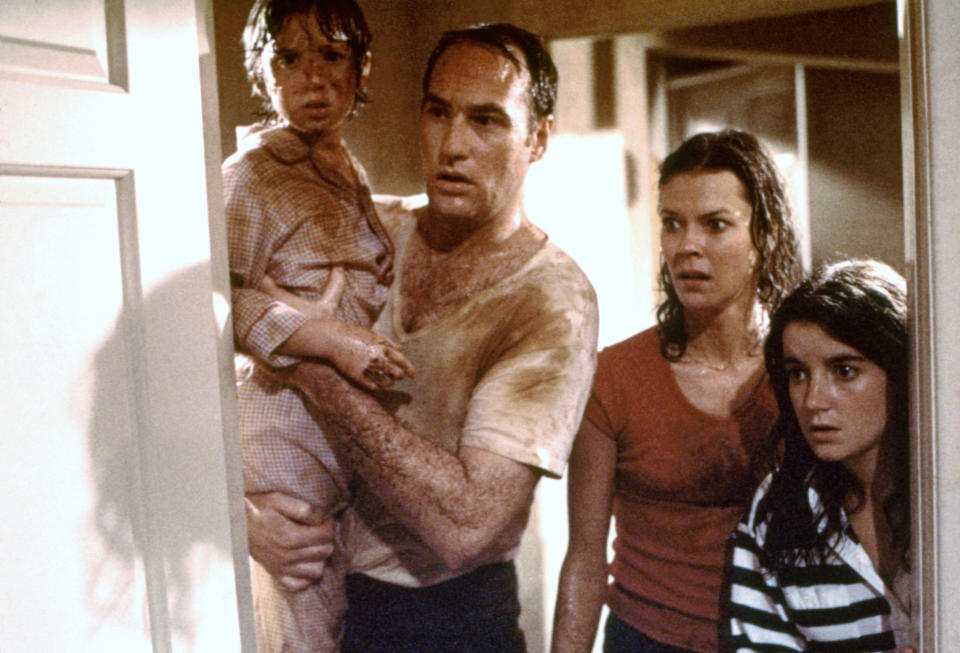Poltergeist has been haunting ’80s kids — and their descendants — for 40 years. But the 1982 blockbuster, directed by Tobe Hooper and produced by Steven Spielberg, has been haunted itself by the so-called “Poltergeist Curse,” an urban legend that’s taken root since the deaths of four cast members from the original film and its two sequels.
Those cast members include two members of the Freeling family, the suburban clan headed up by Craig T. Nelson and JoBeth Williams, whose home is invaded by angry spirits. Five months after the film’s release, Dominique Dunne — who played the eldest Freeling daughter, Dana — was murdered by an ex-boyfriend. And in 1988, her younger onscreen sibling and Poltergeist’s literal poster child, Heather O’Rourke, passed away at age 12 following a serious case of intestinal stenosis. (The other oft-cited curse victims are Julian Beck and Will Sampson, both of whom appeared in the 1986 sequel, Poltergeist II: The Other Side.)
As the last Freeling sibling standing, Oliver Robins — who played middle child, Robbie — has naturally thought a lot about the “Poltergeist Curse,” and how it ties into the legacy of the haunted house franchise.
“I hope there isn’t a curse, because I’m still around,” the child actor-turned-filmmaker tells Yahoo Entertainment ahead of Poltergeist‘s return to theaters as part of the TCM Big Screen Classics Series hosted by TCM and Fathom Events. (Screenings will be held on Sept. 25, 26 and 28; visit Fathom Events for showtime and ticket information.)
[embedded content]
“I do believe in the paranormal to some degree, but I don’t think there’s a curse because those deaths can be explained,” Robins continues. “You had these tragedies happen, but they were going to happen whether [the actors] were in the movie or not. Like with Heather, she had a medical condition for which she wasn’t treated. So I don’t think they are interconnected.”
That said, as a fixture on the horror convention scene, Robins knows that the “Poltergeist Curse” is one of the reasons why the movie still attracts new viewers who might otherwise skip it in favor of more recent frightfests. “I really believe that if you’ve heard about the curse and it gets you to see the film, you’re not going to be on the edge of your seat because of curses — it’s because it’s a great movie. I like to look at the positive side of even the darkest thing.”
Robins is also happy to dispel another myth that’s long surrounded Poltergeist: that Spielberg actually directed the film rather than Hooper. The E.T. director did co-write the screenplay and was an active presence on set, to the point where some crew members have credited him as being its primary creative voice. But Robins insists that Hooper was always calling the shots, at least when he was on-camera.
“Tobe directed me in all my scenes,” he says of The Texas Chainsaw Massacre auteur, who died in 2017. “Steven was there every day and wrote the original screenplay, so it was from his heart. Tobe was following Steven’s vision and if people say it’s a Spielberg movie, that’s because we’re following a script by Steven Spielberg. But at the end of the day, Tobe told me where to stand, where the camera should be placed and everything else. So he truly was the director.”
Robins does credit Spielberg with recognizing and encouraging his youthful interest in filmmaking, though. “I used to make these Super-8 movies while we were shooting,” he recalls. “I brought them in for Steven to see, and he said, ‘Wow! I have a gift for you Oliver.'” That gift turned out to be an upgraded film camera with all sorts of bells and whistles. “You could do anything with it: wind it back, double exposures, shooting sound. So I got to know Steven in a different capacity as an aspiring young filmmaker.”
To celebrate 40 years of Poltergeist, we spoke with Robins about some of the film’s classic scares, and his own real-life close encounters with the paranormal.
It’s always wild to me to think that Poltergeist and E.T. came out within a week of each other back in 1982. Both movies are great genre pieces, but they’re also really relatable portraits of families. You even have your own “penis breath” moment where you and Heather are trading insults at the dining table!
Yeah, that truly was the Spielberg summer. It sounds a little arrogant, but we knew that Poltergeist was gonna be fantastic. Even when we were shooting it, they were already talking about sequels because we were having such a great time. We just wanted to stay together, and it was so sad when we ended production on the first one. What’s so interesting about that scene with Heather is that Tobe was like, “Just be a kid. Do what you would do and ad-lib all those lines.” So half of those lines in the scene — like where I call her a barf bag and she calls me a doggy bag — were just us being kids. We forgot the crew was there! [Laughs]
You hadn’t been in a lot of films prior to making Poltergeist. Did they tell you off the top how scary the movie was going to get?
No, they really didn’t and they kept everything really secret, too. When we auditioned, we had some sides, but they didn’t tell us the story. I had trouble learning to read and my mom said, “I’m not going to read the script to you. If you want to learn to read, read the screenplay for Poltergeist.” So that’s actually how I learned to read! And that’s the first time I learned the movie was scary at all.
What did you think as you were reading all those scary moments on the page?
I was amazed by it, and I didn’t know how they were gonna do it. [Producer] Frank Marshall was so great on the set, and he made it feel like it was gonna be a game every day. He would say, “OK, we have this great tree, and this is what you’re gonna do.” I was a rough-and-tumble kid, so for me it was like being at an amusement park. A lot of people don’t know this, but in the final scene at the Holiday Inn, there’s a sign that says, “Welcome Dr. Fantasy & Friends.” Frank’s nickname was Dr. Fantasy! He does magic tricks and is a great magician himself.
[embedded content]
Did that make it difficult to act scared during those scenes when in reality it was so much fun for you?
I really credit JoBeth Williams, because I had so little acting experience and Tobe expected me to come to set prepared. I said to her, “What do I do?” She talked me though those scenes, and told me to tap into something I was personally really afraid of. Believe it or not, I thought that I grew up in a haunted house. We lived in this townhouse on the Upper East Side of Manhattan in the 1970s and there was this one room that still had red velvet walls left over from the 1860s when it had been a whorehouse right after the Civil War. That room was dark and scary, and I always used to think that I could hear people walking up the stairs at night. My mom would say, “No, that’s just the house settling.” But to this day, I believe I heard people walking up the stairs. So I channeled those feelings [into Poltergeist], thinking about those ghosts and feeling like there’s no one there to protect me.
Did you have any other paranormal experiences in that house?
No, I never really saw anything — it was just that gut-wrenching feeling. I do remember that I had a little playhouse in my room, and I always thought that someone in that playhouse was waiting for me! I’d sit in my bed and pull the covers up over my head. If there was a ghost there, I have to credit it with my performance! [Laughs]
A few years ago, I went to this [haunted] sanitarium in Kentucky with a couple of actors [from other horror movies]. We were all thinking, “This is kind of a joke,” but we ended up seeing things that we can’t understand to this day — like we saw things darting from door to door. So you have to keep an open mind. I think science will eventually explain everything that we call the paranormal, but there are certainly things we don’t get in this world.
You mentioned the tree scene earlier — how was that stunt accomplished?
Well, that involved two weeks of being covered in molasses and being hit with sugar glass and rain! People have to understand that there wasn’t CGI back then, so all of the effects were practical. Basically, they had three or four different trees: one that looked really big, another one for the arms and another one to swallow me. That was a heavy duty special effect. I was standing on a platform and Tobe said, “We need to simulate you getting eaten, so you need to pull away like you’re struggling to get away from the tree.”
But in fact I had to actually lower myself down, so they could add all the special effects. So I would lower myself on the platform and scream, “It’s eating me!” Every shot took a lot of time to do, and they had to make it very safe. I remember when the tree’s arms were coming into the room, the stunt coordinator, Glenn Randall, told me: “Oliver, I want you to cover your eyes, because we want to shoot sugar glass at you.” I never got hurt or anything like that. I do remember that the arms once came through and knocked me off the bed because they didn’t have them at the right angle. But they were incredibly cautious. It just goes to show you that if you rush something or don’t have the right people on set, that’s when errors happen and people get hurt in the process.
For the scene where Heather’s voice is coming out of the television and you’re all trying to find her, did they actually play her voice on set?
No, we would find our places on set and they’d have a stick, and would tell us to follow the stick because that’s where her voice was. All the voiceover and ghost effects were done months later, so in every scene we’re truly acting against nothing. I remember asking Tobe, “What exactly am I screaming at?” And this is what Tobe told me: “We don’t know Oliver, but it’s the scariest thing you can possibly think of.” [Laughs]
[embedded content]
The “monster in the closet” scene is one of my favorites. How difficult was that to film?
That scene was shot in what they called “the Gimbal Room.” It was on the same MGM stage where they filmed all of Fred Astaire’s dances. I remember that the room actually rotated to the left, and the camera was positioned below me. And then we had these wires that were attached to the wall, and we had to act like we were being sucked into the closet. We were given various eyelines for where to look while we were holding onto the bedposts. It was my understanding that they had to blow up each frame and have effects artists paint out the wires. We didn’t see the creature’s esophagus at all. That was an optical illusion that they put in later. They also had fish tanks that they reflected the light through and a big wind blower that would blow our hair. I didn’t know what it was going to look like until I did ADR on the film!
As you’re running out of the house after that scene, all these skeletons start popping up in your way. Was that all carefully choreographed?
Oh yeah, it was very choreographed. The ground of the set would open up and they’d pop a coffin through, so he had to hit a specific mark. There were so many things you could fix today in post-production, but back then you couldn’t fix them and would have to re-shoot. At a minimum, we would do 12 takes on any given shot to make sure we had it. And I was actually scared during that sequence. When there’s a coffin popping up in front of you, it doesn’t take that much acting to be terrified! I asked the prop guys, “Are the skeletons real?” They said they were, but I don’t know if they were just trying to scare me. I don’t know if this is true, but later on I heard they did use real skeletons. [Both Williams and some of the film’s crew members, have since said that several of the skeletons featured in that scene were real.]
What was your favorite scene that you weren’t on set for?
I would have liked to have seen JoBeth in the pool where all the skeletons are popping up out of the water. That was not in an actual backyard, but on a soundstage, too. I loved being on set, but the labor union was like, “You gotta go home,” so they had to drag me off. Otherwise I would have hung out and watched that scene.
I thought you might have picked the face peeling moment.
I actually was there for that one! Believe it or not, those are Steven’s hands. Tobe was directing him, saying, “OK Steven, your hands have to go here.” So he was the actor and those are his hands and he’s actually tearing at his face. I think it was Rick Baker who created that mold and the only had one of them so that they had to get it right.
[embedded content]
I remember Poltergeist II being even gnarlier than the original movie. Was that the plan — to have the movies get scarier as they went along?
You know, I wasn’t privy to that information. It was probably just commerce. I was 14, and didn’t have the best working relationship with [director] Brian Gibson on that set. My understanding is that MGM was in financial difficulty at that point, and wanted to shut down production, so he was under duress the entire time, which made it really tough. And I was a precocious, obnoxious teenager with a mind of my own, so I really talked back to him. Poltergeist II didn’t really have the same energy or vibe as the first one, and I think that was beyond anyone’s control. We didn’t have that family element because we were under duress from all these exterior forces. As a filmmaker myself, it’s hard to ignore those things as much as you might want to.
Was there ever any discussion about you returning for Poltergeist III?
They never contacted me, so I didn’t really know about it. I probably would’ve done it, but at that point, I wanted to go to USC film school so I was really focused on my studies. If I had been told that I had to skip a biology final to focus on acting, I would have been like, “No, biology has to come first.” [Laughs]
[embedded content]
Heather’s death was a big shock to everyone: Was it hard to lose her that way?
It really was. I hadn’t really lost that many people in my life at that point, and I was so close with her. She was my buddy, and used to stay over at my house. I didn’t know anything was wrong with her. It was such a horrible tragedy, and I honestly didn’t know how to deal with it. It was kind of a turning point in my life where it made me wake up to that reality that life is finite and every day is truly precious.
You mentioned that you’re not necessarily a believer in the paranormal, but do you feel her presence when you rewatch the film?
I do feel her that she’s there, although that could just be part of my mind. She was such a great actress, and so smart and precocious. I’ve worked with children as a director since that time, and you kind of take for granted how amazing she took to it. I’ve directed kids that don’t listen and can’t take direction, but Heather was like a little adult when she was on set. She was very special, and that’s why Steven and Tobe hired her for that role.
When you go to horror conventions now, what’s the reaction you’re always happy to hear from fans?
The thing that always sticks with me is when fans that are grown-ups like me bring their kids and try to express to them why this movie is great, and they use me for that moment. They’re trying to share that moment when they were 10-years-old watching Poltergeist with their own 10-year-olds and when the kids meet me, it all comes alive. I like to be a part of that, and I love talking about Poltergeist with fans. When the movie came out, I always wondered what people where thinking when they saw it, and now I get to hear all those stories. The key thing is that the film itself is a wonderful movie that obviously has staying power, because we’re still talking about it 40 years later.
Poltergeist returns to theaters Sept. 25-28 as part of Fathom Events’s TCM Big Screen Classics series; visit Fathom Events for showtime and ticket information




